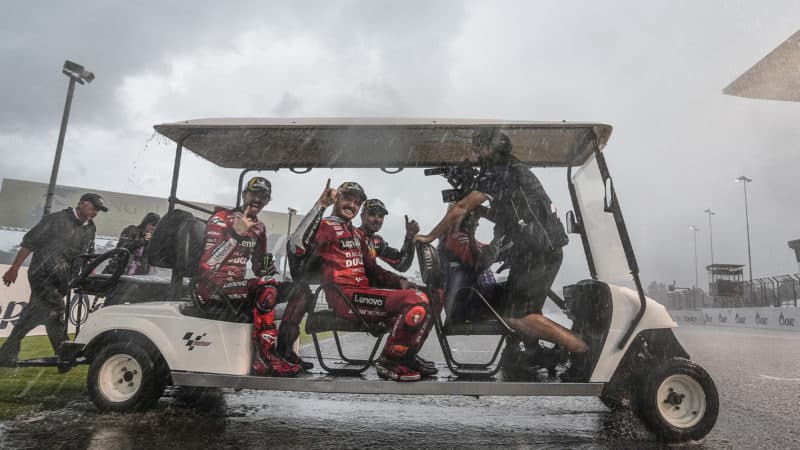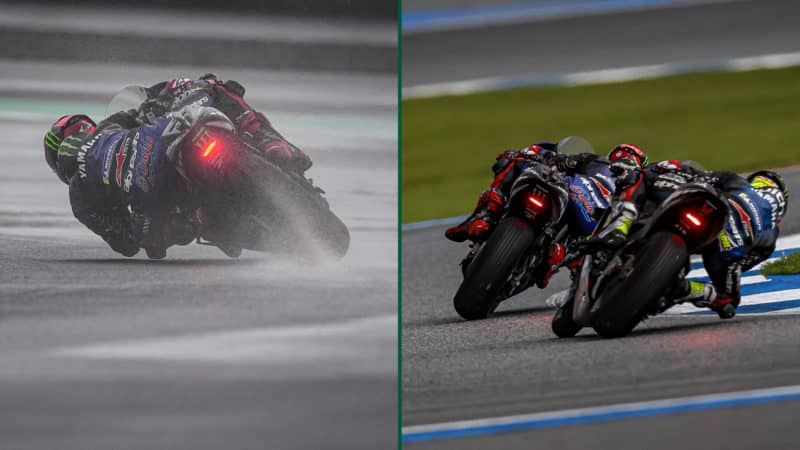But you need grip to go fast. Quartararo’s secret is extracting huge grip from the M1, by dancing all over the bike, transferring load between the tyres, and playing with the throttle and brakes. This allows him to use lots of corner speed to overcome the horsepower advantage enjoyed by his rivals, especially his Ducati rivals.
In the rain, however, there’s little edge grip to be had from the tyres, so yesterday his only advantage was cancelled out. But, you say, what about Mandalika in March, where Quartararo finished second in the rain-lashed Indonesian GP just behind Oliveira? Mandalika had so much grip in the rain that riders were scraping their elbows like they do in the dry. The only riders who got their elbows down at slippery Buriram yesterday were Remy Gardner and Luca Marini when they hit the deck.
Just two crashes during a race that started in tropical-downpour conditions and ended on a drying track was impressive stuff from Michelin’s rain tyres.

Bagnaia chases Oliveira in the early stages as the KTM rider makes his charge towards the front
KTM
Wet races tend to be won by the fastest bikes, because they can tiptoe around the turns then blast down the straights, which is why Buriram was all about MotoGP’s more powerful V4s, with not one inline-four finishing inside the top ten. Quartararo finished 17th, 34 seconds down, returned to his garage and walked out of the back without talking to anyone. Understandable in the circumstances – he’s just spent three weeks in hell.
The top five was one KTM, three Ducatis and one Honda, covered by less than three seconds, an average lap time difference of just 0.118 seconds. That’s how close MotoGP is at the moment, even in the rain.
Of course, everyone was asking why Oliveira and the KTM are so good in the wet, after their second consecutive victory in a Southeast Asian deluge.
Miller took four points off his team-mate, which may or may not prove crucial in the title fight
The RC16 has always been good in the rain – the bike scored its first podium at the rain-lashed 2018 Valencia GP – which means its wet-weather engine, electronics and chassis settings allow the rider to get the maximum from the bike from minimal grip. This gives the rider the confidence he needs on a slippery racetrack, plus Oliveira has a smooth riding technique, with smooth throttle control. I think this may be one reason he’s leaving KTM – in the dry the RC16 needs to be grabbed like a bull by the horns and that’s not really his style.
Also, perhaps rainfall masks the one deficiency that prevents the RC16 from winning in the dry right now. The bike doesn’t quite turn well enough – it uses wider-radius cornering lines that prevent riders from getting on the throttle as soon as they’d like.
Just as the KTM is so good in the wet, so was Bagnaia always bad in the wet. But, wow, did he turn that around just in time. This was the 25-year-old Italian’s first full-wet race podium in MotoGP and the last time he made the top three in the rain was way back at the 2017 San Marino GP, in Moto2.

Miller building his title attack, while Márquez builds his attack on Bagnaia, which was thwarted by Zarco
Ducati
Funnily enough, Bagnaia’s mentor Valentino Rossi was the same. “I don’t like riding under the water!” he used to say during his early years in GPs. At one race during Rossi’s debut GP season it was raining so hard at the start of Friday morning practice that he shut himself in his campervan, but he too learned to walk on water.
Riding in the rain is all about confidence – you can’t go full-attack, you have to ease into it, feel the grip and ride to that grip. When Bagnaia woke up on Sunday morning and saw the forecast he thought he was in trouble. “Then when it started raining I was a bit nervous and at that moment Jack came to me and said something about believing more in myself in those conditions.”



